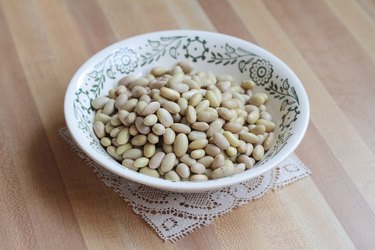
Mayocoba beans are medium-sized, ivory-colored beans native to South America. Also known as the Peruano beans, azufrado beans, canario beans, maicoba or Mexican yellow bean, cooked mayocoba beans have a mild flavor and creamy texture.
Beans and legumes, such as mayocoba beans, can be used as a substitute for pinto, cannellini or great northern beans in soups, stews, chili, salads or traditional Hispanic dishes. Most beans provide fiber, protein, iron and even some calcium, according to nutrition information provided by the USDA.
Video of the Day
Video of the Day
Canned mayocoba beans can contain a high concentration of sodium — drain and rinse canned beans prior to consuming them or added them to other dishes, as recommended by North Dakota State University.
The American Heart Association recommends a maximum daily intake of 2,300 milligrams of sodium. Cooking your own beans will allow you to control the sodium content as well as the finished beans' texture.
Cooking Mayocoba Beans
Cooking dried mayocoba beans requires a few simple steps and minimal kitchen equipment, including a colander or strainer, a large stockpot with a tight-fitting lid and a spoon.
Step 1: Rinse the Mayocoba Beans
Place the dried mayocoba beans in a colander or strainer, removing any stones, debris and discolored or broken beans. Rinse the beans thoroughly under cool, running water.
Step 2: Add Some Water
Put the beans in a large stockpot. Add enough cold water to cover the beans by 2 to 3 inches — dry beans will soak up the water as they cook, according to Michigan State University.
Step 3: Boil the Beans
Bring the water to a boil over high heat. Allow the bean and water mixture to boil for approximately two minutes.
Step 4: Let Beans Sit
Turn off the heat. Put the stockpot's lid in place and let the beans sit, undisturbed, for two hours.
Step 5: Simmer the Beans
Turn the heat back to high and bring the water to a boil. Reduce the heat so that the water is at a gentle simmer. Adjust the pot's lid so that it is not completely covering the pot.
Step 6: Check the Tenderness
Use a spoon to remove a few mayocoba beans after 10 to 15 minutes and check them for tenderness. Continue to check the beans every 10 to 15 minutes until they've reached your desired level of tenderness.
Step 7: Drain the Beans
Drain the mayocoba beans. Add them to your favorite dish or store them after they've cooled.
Read more: Red Kidney Beans Health Risk
Consider These Tips
To store cooked mayocoba beans, spoon them into a plastic container that has a tight-fitting lid and add enough of the cooking water to cover the beans.
Eating beans may cause flatulence in some people. Try discarding the soaking water and adding fresh water before cooking the beans, as recommended by Cleveland Clinic, to reduce this unwanted side effect.
You can also use an over-the-counter enzyme preparation to reduce gas production when consuming mayocoba beans. In some Asian cultures, a strip of kombu — a type of dried kelp — is added to the water when cooking the beans to make them more digestible, according to Cleveland Clinic.
- North Dakota State University: "All About Beans Nutrition, Health Benefits, Preparation and Use in Menus"
- Michigan State University: "How to Cook a Variety of Nutritious Beans"
- Cleveland Clinic: "What You Should Know About Beans and the (Embarrassing) Gas They Cause"
- American Heart Association: "How Much Sodium Should I Eat Per Day?"
- USDA FoodData Central: "Great Northern Beans"